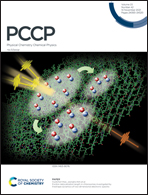Computational UV spectra for amorphous solids of small molecules
Abstract
Ices in the interstellar medium largely exist as amorphous solids composed of small molecules including ammonia, water, and carbon dioxide. Describing gas-phase molecules can be readily accomplished with current high-level quantum chemical calculations with the description of crystalline solids becoming more readily accomplished. Differently, amorphous solids require more novel approaches. The present work describes a method for generating amorphous structures and constructing electronic spectra through a combination of quantum chemical calculations and statistical mechanics. The structures are generated through a random positioning program and DFT methods, such as ωB97-XD and CAM-B3LYP. A Boltzmann distribution weights the excitations to compile a final spectrum from a sampling of molecular clusters. Three ice analogs are presented herein consisting of ammonia, carbon dioxide, and water. Ammonia and carbon dioxide provide semi-quantitative agreement with experiment for CAM-B3LYP/6-311++G(2d,2p) from 30 clusters of 8 molecules. Meanwhile, the amorphous water description improves when the sample size is increased in cluster size and count to as many as 105 clusters of 32 water molecules. The described methodology can produce highly comparative descriptions of electronic spectra for ice analogs and can be used to predict electronic spectra for other ice analogs.



 Please wait while we load your content...
Please wait while we load your content...